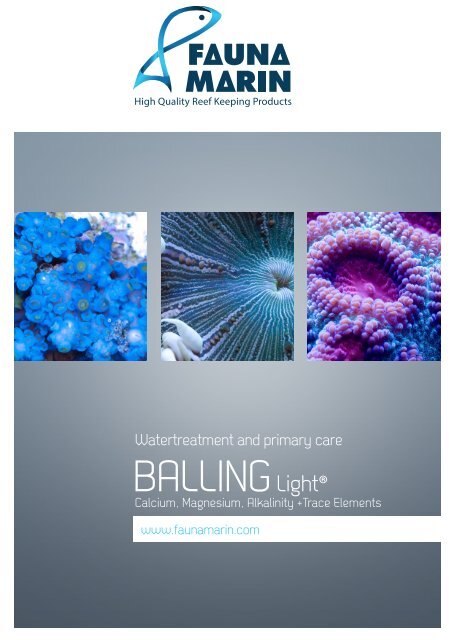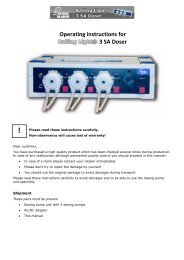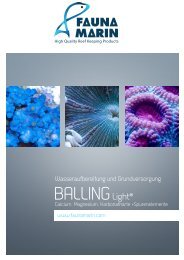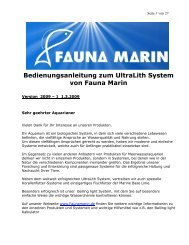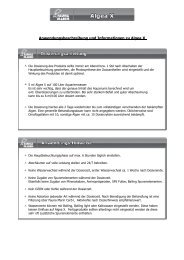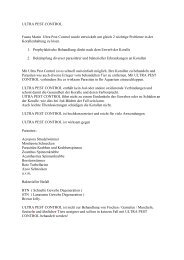Water treatment using the method - Fauna Marin GmbH
Water treatment using the method - Fauna Marin GmbH
Water treatment using the method - Fauna Marin GmbH
Create successful ePaper yourself
Turn your PDF publications into a flip-book with our unique Google optimized e-Paper software.
High Quality Reef Keeping Products<br />
High Quality Reef Keepin<br />
<strong>Water</strong><strong>treatment</strong> and primary care<br />
BALLING Light®<br />
Calcium, Magnesium, Alkalinity +Trace Elements<br />
www.faunamarin.com
Introduction<br />
The well-known and popular Balling <strong>method</strong> is an extremely simple <strong>method</strong> for providing<br />
your aquarium with calcium, magnesium, carbonate hardness and trace elements.<br />
In Germany this <strong>method</strong> has practically replaced <strong>the</strong> previously popular calcium reactor. An<br />
increasing number of marine aquarists also use our <strong>Fauna</strong> <strong>Marin</strong> Balling salts with a calcium<br />
reactor in order to manually compensate for chemical imbalances, such as those that can<br />
occur when operating such a reactor.<br />
To provide an optimum supply for a marine aquarium, <strong>the</strong>se substances are added<br />
daily by hand or <strong>using</strong> a dosing pump. Strong lighting, stony coral husbandry, artificial<br />
reef decoration and special bacterial preparations have changed <strong>the</strong> water chemistry<br />
requirements and made it necessary for <strong>the</strong> Balling Classic <strong>method</strong> to be adapted.<br />
With this in mind, <strong>Fauna</strong> <strong>Marin</strong> have developed a new Balling <strong>method</strong> approach and adapted<br />
it to <strong>the</strong> present conditions of modern reef aquaristics.
Introduction<br />
Our salts comply with pharmaceutical purity levels and are packaged accordingly in a<br />
protected manner. Not only do we take <strong>the</strong> datasheet into consideration – we also check<br />
organic and inorganic trace elements as well as <strong>the</strong> effectiveness of <strong>the</strong> salts.<br />
In our salts we use additional bioactive stabilisers, pH buffers and special minerals which<br />
significantly increase <strong>the</strong> stability of <strong>the</strong> chemical parameters in <strong>the</strong> aquarium.<br />
The added trace elements are more stable in <strong>the</strong> solution and are <strong>the</strong>reby more accessible to<br />
<strong>the</strong> coral.<br />
By <strong>using</strong> salt mixtures, this Balling Light ® <strong>method</strong> brings with it minerals and trace elements<br />
that are ei<strong>the</strong>r missing from or only present in small amounts in commercially available sea<br />
salts. The supply of bioactive components and <strong>the</strong> purity of <strong>the</strong> salts prevents <strong>the</strong> coral from<br />
darkening and enhances its growth and colouration.<br />
<strong>Fauna</strong> <strong>Marin</strong> Balling salts are simply beyond comparison!<br />
• More effective, thanks to <strong>the</strong> highly purified salts with extremely low water content<br />
• Salt mixtures for improved stability of important parameters<br />
• Tailored to modern sea salts<br />
• Stable PH value<br />
• Supply of bioactive substances for improved colouration and coral growth
Fundamental Values<br />
The following values should be produced during continuous<br />
operation.<br />
• Calcium 380 – 420 mg/litre<br />
• Magnesium 1200 – 1350 mg/litre<br />
• Alkalinity 6,5 – 8 dkH<br />
• Salinity 33 – 35 per mil<br />
Instructions for <strong>the</strong> Balling Light <strong>method</strong><br />
Three 5-litre canisters are to be prepared separately<br />
CAUTION Always add <strong>the</strong> salt to <strong>the</strong> water – never <strong>the</strong> o<strong>the</strong>r way round!<br />
1st Canister - Calcium<br />
Dissolve 2.0 kg of <strong>Fauna</strong> <strong>Marin</strong> calcium chloride dihydrate mixture into 4 litres of osmosis<br />
water and <strong>the</strong>n fill <strong>the</strong> canister with osmosis water.<br />
Then add:<br />
• 25 ml Ultra Trace B Color and Grow Elements (1) - strontium/barium complex<br />
• 25 ml Ultra Trace B Metabolic Elements (2) - heavy metal complex<br />
to <strong>the</strong> canister.
2nd canister - magnesium<br />
Dissolve 2.0 kg <strong>Fauna</strong> <strong>Marin</strong> magnesium chloride<br />
hexahydrate mixture into 4 litres of osmosis water<br />
and <strong>the</strong>n fill <strong>the</strong> canister with osmosis water.<br />
The new <strong>method</strong> does not require magnesium<br />
sulphate as it becomes too strongly concentrated<br />
and causes ion displacement in <strong>the</strong> aquarium<br />
water.<br />
Nothing else is added to this canister!<br />
3rd canister - alkalinity/carbonate hardness<br />
Dissolve 500 g of sodium bicarbonate<br />
mixture into 4 litres of osmosis water and<br />
<strong>the</strong>n fill <strong>the</strong> canister with osmosis water.<br />
Then add:<br />
• 25 ml Ultra Trace B Health<br />
Elements (3) - iodine/flour<br />
complex<br />
to <strong>the</strong> canister.<br />
Tipps und Hinweise<br />
Larger canisters can also be used; you will simply need to extrapolate <strong>the</strong> quantities added<br />
for each canister<br />
Use lukewarm water to dissolve <strong>the</strong> carbonate. A small residue will always be left over in this<br />
canister. However, this has no effect on <strong>the</strong> stability of <strong>the</strong> solution.<br />
A slight discolouration of <strong>the</strong> solutions is normal, and is due to <strong>the</strong> addition of bioactive<br />
substances and trace elements. This has no impact on <strong>the</strong> quality or stability of <strong>the</strong> solutions.<br />
After dissolution <strong>the</strong> solutions can be stored indefinitely.
The reguarly doasge<br />
The more regularly <strong>the</strong> solutions are added - <strong>the</strong> more stable are <strong>the</strong><br />
values in your system. We recommend <strong>using</strong> <strong>the</strong> <strong>Fauna</strong> <strong>Marin</strong> Balling<br />
Light ® dosing computer, which has been specially developed for this<br />
<strong>method</strong>, or <strong>the</strong> corresponding model from GHL for <strong>the</strong> Profilux aquarium<br />
computer.<br />
The three canisters are now connected to an appropriate dosing computer<br />
via 4/6 mm PVC tubes.<br />
Tip - Drill a small hole into <strong>the</strong> lid of <strong>the</strong> canister and insert a 4 mm PVC<br />
rod all <strong>the</strong> way down into <strong>the</strong> canister. Then connect <strong>the</strong> rod to <strong>the</strong> 4/6<br />
mm tube. You can <strong>the</strong>n use <strong>the</strong> entire contents of <strong>the</strong> canister.<br />
Adding <strong>the</strong> solutions<br />
Depending on <strong>the</strong> content of <strong>the</strong> aquarium, <strong>the</strong> individual solutions are now metered<br />
manually in order to determine <strong>the</strong> actual requirements. Before doing this, determine <strong>the</strong><br />
current water values and make a note of <strong>the</strong> results. (Ca, Mg, Alk)<br />
Example: 50 ml of canister 1 into a 500-litre aquarium.<br />
Value before dosing = 380 mg of calcium. After 2 hours, repeat <strong>the</strong> test <strong>the</strong> calcium value<br />
after <strong>the</strong> 2nd test is <strong>the</strong>n 400 mg of calcium. In this example, <strong>the</strong> addition of 50 ml of <strong>the</strong><br />
solution from canister 1 increases <strong>the</strong> calcium value by 20 mg/litre for a 500-litre aquarium.<br />
Now program <strong>the</strong> dosing computer to add 7 ml of solution 1 once a day, i.e. 50 ml of <strong>the</strong><br />
solution spread over a week.<br />
After a week measure <strong>the</strong> calcium value again and note it has only risen to 390 mg/litre,<br />
although in a pure arithmetic sense this should have risen to 400 mg/litre.<br />
This <strong>method</strong> determines <strong>the</strong> actual loss of calcium that is to be compensated in <strong>the</strong> system.<br />
Due to chemical precipitation, growth or <strong>the</strong> use of water <strong>treatment</strong> agents, <strong>the</strong> actual calcium<br />
loss that is determined may differ from <strong>the</strong> calculated value.<br />
You can now easily adjust <strong>the</strong> dosage level by increasing <strong>the</strong> value by 3 ml per day. 50 ml =<br />
+20 mg/7 days = 7 ml<br />
Therefore, to obtain <strong>the</strong> value + 30 mg, 75 ml/7 days = 10 ml must be added.Using this<br />
simple 3-part calculation you can easily adjust each of your desired values and set an<br />
automatic dosing schedule in just a few days.<br />
A daily inspection of <strong>the</strong> calcium (Ca test), magnesium (Mg test) and dKH values (KH test) is to<br />
be conducted at <strong>the</strong> start and <strong>the</strong> dosing quantity must be adjusted on <strong>the</strong> device if necessary.
Advice<br />
The <strong>Fauna</strong> <strong>Marin</strong> dosing computer is ideal for this application, as each channel can be<br />
individually adjusted and <strong>the</strong> substances can be dosed at 5 minute intervals twice per day.<br />
After no more than 2 weeks, you will have determined <strong>the</strong> specific requirements for your<br />
aquarium and set <strong>the</strong> dosing unit accordingly.<br />
The fact that mineral salt is no longer used for <strong>the</strong> Balling Light ® <strong>method</strong> (this is used in <strong>the</strong><br />
traditional <strong>method</strong>) is not only due to regular water changes, but <strong>the</strong> volume of dissolved<br />
trace elements in our aquariums, which is generally too high.<br />
Therefore, <strong>the</strong> often mentioned ‚ion displacement‘ factor is only applicable based on<br />
<strong>the</strong>oretical consideration of <strong>the</strong> Balling <strong>method</strong>. The regular exchange of water helps your<br />
system to dilute unwanted substances and it makes it very easy to adjust and control salinity<br />
levels.<br />
The addition of trace elements in <strong>the</strong> canister is used to compensate (balance) <strong>the</strong> Balling<br />
solutions and provides a nature similar water chemistry in your reefaquarium.<br />
If you have <strong>the</strong> need for an additional dose of elements (coloration), use our new Color<br />
Elements. T hese additional elements can significantly enhance <strong>the</strong> colors of your corals and<br />
stimulate growth.<br />
Naturally, <strong>the</strong> system is also suitable for manual dosing. To do this add <strong>the</strong> solutions to a<br />
well-circulated area of <strong>the</strong> tank. There should be an interval of approx. 10 minutes between<br />
<strong>the</strong> doses. Start by adding magnesium, <strong>the</strong>n calcium and carbonate.<br />
Correct measure<br />
We recommend that you verify your water tests with <strong>the</strong> reference solution from <strong>Fauna</strong><br />
<strong>Marin</strong>. We can also provide you with an exceptionally accurate KH test for marine aquariums.<br />
Please measure <strong>the</strong> salinity of your aquarium on a regular basis and adjust it if necessary. To<br />
do this, use a refractometer (regularly calibrated with <strong>the</strong> <strong>Fauna</strong> <strong>Marin</strong> Multi Reference) or a<br />
high-quality aerometer, e.g. from Tropic <strong>Marin</strong>.<br />
Questions, contacts, support<br />
We wish you lots of success <strong>using</strong> this new <strong>method</strong> and we are happy to answer any fur<strong>the</strong>r<br />
queries you may have.<br />
info@faunamarin.de<br />
www.facebook.com/claude.schuhmacher.9<br />
www.meerwasserforum.info<br />
www.riffaquaristikforum.net<br />
www.ultimatereef.net<br />
www.reef2reef.com
High Quality Reef Keeping Products<br />
High Quality Reef Keep<br />
<strong>Fauna</strong> <strong>Marin</strong> <strong>GmbH</strong><br />
Gottlieb-Binder-Str. 9<br />
D-71088 Holzgerlingen<br />
Tel.:+49 (0) 7031 427 1142<br />
Fax:+49 (0) 7031 238 592<br />
www.<strong>Fauna</strong><strong>Marin</strong>.de


